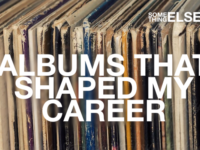by Mark Saleski
Being the musical egghead that I am, I tend to be very fond of Frank Zappa’s thoughts on composition. In particular, the idea that anything can be music. Yes, anything — “Anything can be music, but it doesn’t become music until someone wills it to be music, and the audience listening to it decides to perceive it as music. Most people can’t deal with that abstraction — or don’t want to.”
Zappa goes on from there to his complaint about people wanting what they know. It’s sort of true, although I don’t really get as worked up about it as he did. Hey, some people just want to have some fun, challenge not being a requirement for every listening experience. Count me in that camp too. Heck, I’ve been known to finish out the work day with some Commander Cody. Who needs high art when you’re only looking for a smile and a shot of the energy of the familiar?
Somewhere in between these ghettos of art (both low and high) lies the loft of music concrete. It’s a form (hmmm … almost hate to use that word here) of composition that gets its source material, concepts, and sounds from the real world and its goings on. The screech of subway brakes, the chirp of birds, the rattle of industrial equipment. The RPM Orchestra reminds me that these concept have always held a lot of resonance. Not only do I experience unusual things as music, but often I hear bits of “normal” music emanating from their intersections.
The idea of extending the definition of music so that it pushes back into everyday objects and situations isn’t all that outlandish. Not too many years ago, Steve Reich built a composition based on words being spoken about a train trip to Chicago. Yes, Different Trains was quite an ear-opener. More recently, there is Nico Muhley’s Mothertongue.
On Afterglow, collages of samples are move around and glued together to create distinctly dreamlike suites of found sound. The combinations are quite moving, even if they don’t always tell a direct story: an old jazz band with spooky messages from an espionage “counting station” running underneath, a classical composition played in the background as it is subsumed by flames in the fore, the natural reverb in large, public spaces. The sound of rain, mid-downpour, trying to drown out the wind chimes, one single muted piano note far in the background … an operatic voice can be heard off in the distance, television dialog colliding with cycling radio signals, the refrain of participants at a religious service just before breaking out into song … a song that itself generates disturbing synthesized echoes.
I’m not sure what it takes to enjoy this kind of music. It has a certain ambient nature, but is so full of detail that a person can easily lose the aural image if they’re not lending their full attention. The RPM Orchestra leaves a succinct note on their MySpace page: “Musique Concrète for the masses.” Cute, in a musical egghead kind of way.
RPM Orchestra’s ‘Afterglow’ is still available, though in a limited quantity, through the band’s Web site.
- Why the Rolling Stones’ Harrowing ‘Gimme Shelter’ is Still Revealing New Depths - November 18, 2024
- How Talking Heads’ ‘Fear of Music’ Opened Up a World of Art and Sound - August 5, 2024
- How Deep Cuts Propelled Bruce Springsteen’s ‘Born in the U.S.A.’ - June 4, 2024



